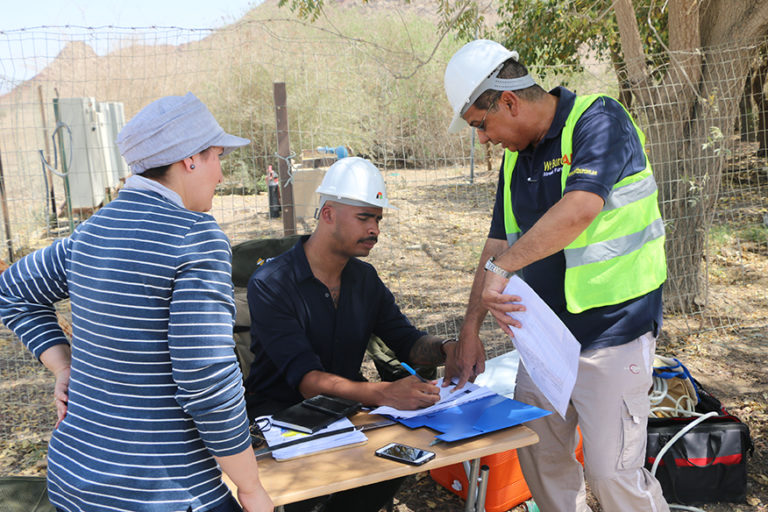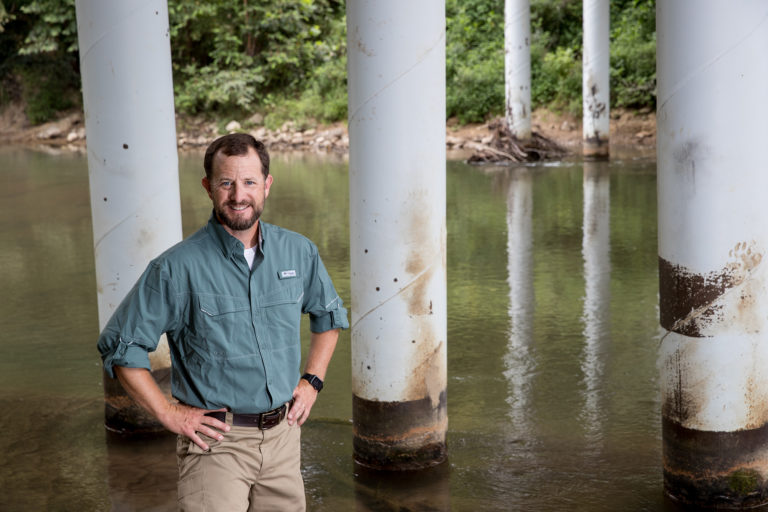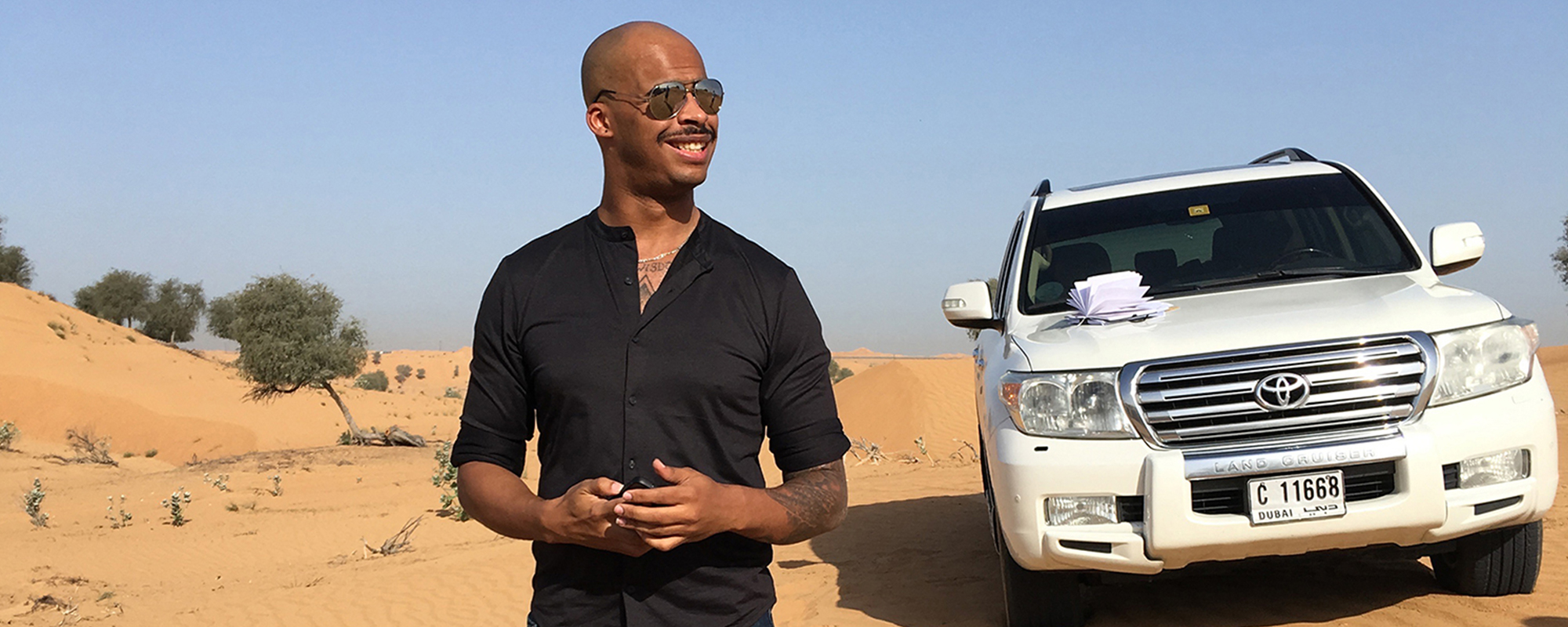By Erin Chesnut
William Abrams (Martin ’15) literally is finding water in the desert.
“Water is arguably the most important natural resource. It is essential for life. It’s easy for us in the eastern United States to take it for granted, given how abundant it is here, but in many other regions, such as the Middle East and North Africa, water stress due to scarcity is a dire issue,” he says.
While a lack of drinking water is an obvious problem in many areas, water stress also contributes to some of the world’s greatest conflicts. When citizens lack water to grow crops, feed livestock and care for their families, individual hardships often turn into local violence, which then spreads and has the potential to become national or even global warfare.
Abrams, who finished a master’s degree at the University of North Carolina Wilmington in July, hopes to help change that with his research in geospatial science and the locating of groundwater aquifers in water-scarce regions.
Working in the Middle East, specifically the United Arab Emirates and Oman, Abrams uses satellite imagery to map and analyze geology, topography and climate to create models and maps showing likely areas of groundwater recharge and accumulation. “The end use of my master’s research is to guide local governments to promising areas so they may exploit these water resources for their citizens,” he says.
So far, Abrams’ field work in the United Arab Emirates has discovered underground water resources to help provide drinking water for a region of about 10 million people.
Abrams found his path through an undergraduate research project.
He worked alongside UT Martin’s Stan Dunagan, professor of geology, and Robert Simpson, professor of geography, investigating irrigation wells in West Tennessee. He studied the number and concentration of irrigation wells drilled during the past two decades to help determine which underground aquifers are most commonly accessed across the region. With the help of William Mann, a geologist with the Tennessee Department of Environment and Conservation’s Jackson office, Abrams and Dunagan determined that the number of irrigation wells in West Tennessee jumped from 26 reported in 2000 to 1,174 reported in 2014. That total has since risen to more than 1,500, according to Mann.
And that growing number of wells could lead to issues in the future.
“There will, at some point, be competition between cities and other private users of water, especially in West Tennessee, because in West Tennessee, we’re all going after groundwater. The central pivots (large agricultural irrigation systems) utilize water from the same aquifers that (the city of) Martin draws from, as well as other major users in West Tennessee—Memphis, Shelby County and Madison County in particular,” says Dunagan.
However, as visible as agricultural irrigation systems are in the region, the percentage of water used by agriculture statewide is significantly smaller than that used by Tennessee’s coal-burning power plants. According to U.S. Geological Survey data collected in 2010, thermoelectric power plants in Tennessee use 5,800 million gallons of water a day, while the state’s agricultural industry uses only 71.9 million gallons a day. As these power plants are constructed farther away from rivers and other surface water, more and more of the industry turns toward underground aquifers.

Users often see water as a renewable resource. This is not always the case, Dunagan says, even in water-rich climates like the Southeastern United States.
“Tennessee, in general, is blessed in terms of having really good aquifers, and some of the major ones in the United States are in Tennessee. In fact, two of the major ones are actually in West Tennessee,” he says. “The one that gets regularly recharged is right along the Mississippi River, and it’s probably hydrologically connected to the river somewhat…(However) most of the groundwater that we use in these underground aquifers is probably centuries to thousands of years old, so once it’s used in our lifetime—it literally is a nonrenewable resource.”
When they’re gone, the problems will start.
In fact, disputes over water resources—both on land and underground—have created litigation among private citizens and among cities, counties, states and countries for centuries. The state of Mississippi is currently framing a lawsuit against the state of Tennessee, a Memphis utility company and other entities over groundwater resources.
“They (the state of Mississippi) argue that Memphis Light, Gas and Water diverted groundwater out of Mississippi into the state of Tennessee, and they say they are owed hundreds of millions of dollars in damages,” says Dunagan. He also cites the ongoing conflict with the Georgia legislature, which has argued that the Tennessee-Georgia boundary should be moved north by 100 feet. This move would give Georgia equal access to the Tennessee River and legal usage rights to the water within it.
“What you will see in the future are further problems with water resources,” says Dunagan. “At some point, there will be another drought, and this will be another problem, whether it’s surface water between Georgia and the Tennessee River or groundwater here in West Tennessee. Water resources in the future will continue to be an ongoing issue.”

PHOTO BY RAFFE LAZARIAN / UT MARTIN
Only the federal government and states own water, though property owners have the right to reasonable use of water in a stream or lake on their property.
“If you’ve got a thousand acres of corn that need irrigating, reasonable use would be a lot of water, but if you’ve got a 2,000-square-foot house, your reasonable use is going to be much less. So balancing those two things will be very important going into the future, not only for our state but for the whole country,” he says.
Abrams has taken this regional outlook and problems and expanded his vision to the world’s deserts. He hopes his research will help countries have greater access to water and develop policies and regulations for handling water disputes without resorting to violence.
“As water is something we cannot do without, it’s crucial to examine and protect the water resources we have before any problems arise,” he says. “By doing so, we can have plans or, at the very least, have a baseline from which to form plans that can mitigate issues down the line.”



